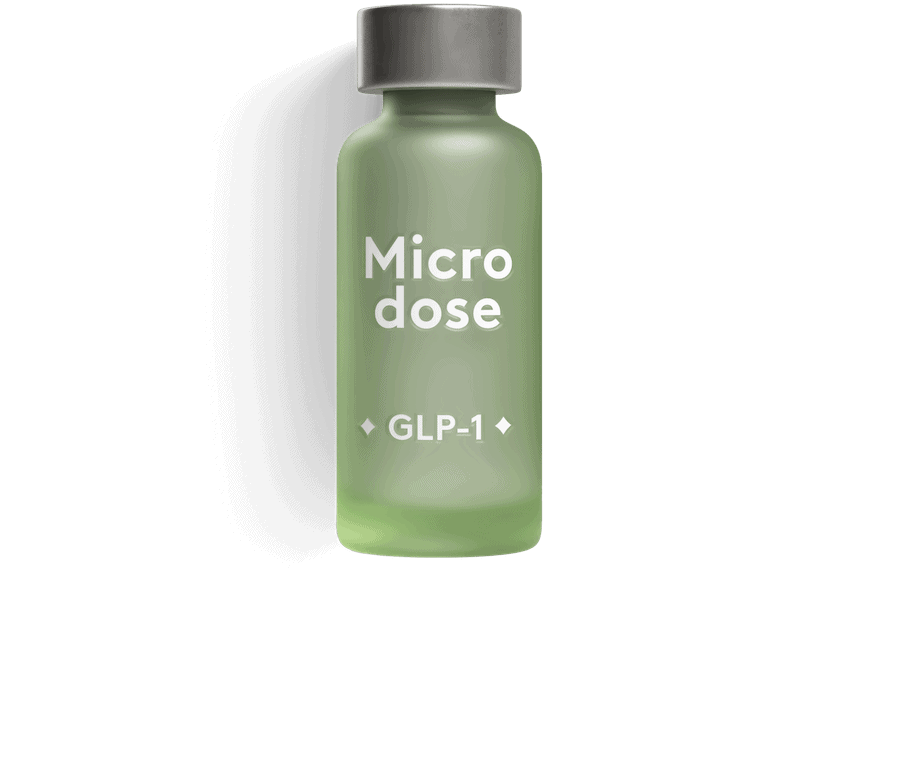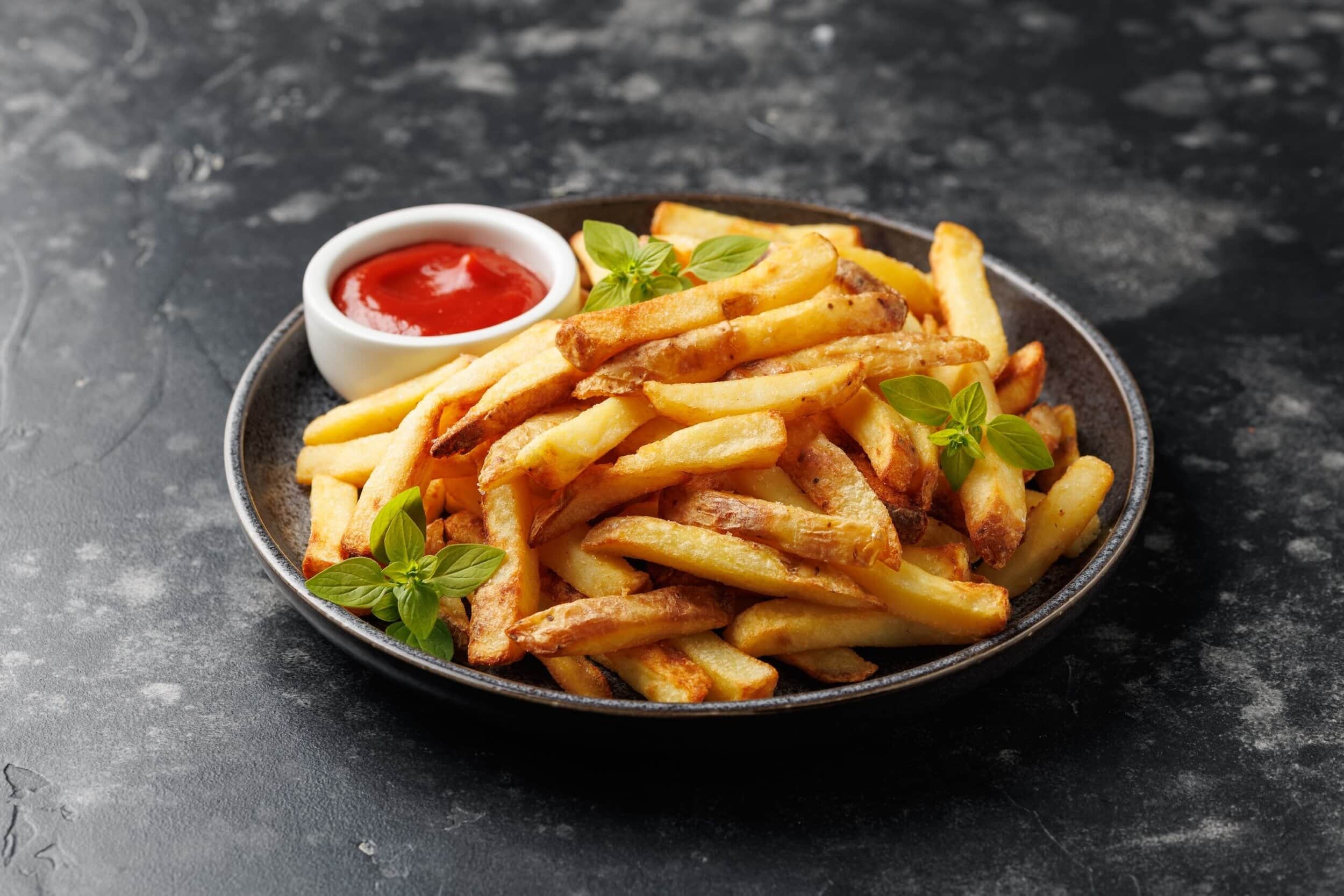Croissants are one of those foods that feel both simple and special. Warm, flaky, and buttery, they’re a go-to at coffee shops and weekend breakfasts everywhere. But if you’re trying to lose weight, you might wonder whether this classic pastry fits into your plan.
A croissant isn’t nutrient-dense; it’s higher in calories and lower in protein than eggs and lower in fiber than oatmeal. Still, a plain croissant has fewer calories than many other bakery favorites, such as bagels with cream cheese, donuts, or large muffins. The key is awareness and balance: understanding what’s in it and how it fits into your overall eating pattern can help you enjoy it occasionally without losing progress toward your goals.
✅ Quick answer
No, croissants aren’t typically a great choice for weight loss due to their low-nutrient density, refined carbohydrates, and saturated fat content. A medium croissant (60g) contains about 240 calories.
🚀 Weight-loss benefits of croissants
- They’re pre-portioned – Unlike a tub of ice cream or a bag of cookies, a single croissant comes naturally portioned. That makes it easier to practice portion control and stay within your calorie goals. Choosing a small or mini croissant can help you satisfy a craving without going overboard.
- They provide psychological satisfaction – Including foods you genuinely enjoy can actually support long-term success. Allowing yourself a croissant as a planned treat encourages mindful eating and reduces the restrict-binge cycle that can derail progress.
- They can fit into a balanced routine – A croissant can absolutely have a place in your day when paired with nutrient-dense foods. Try enjoying it with a side of Greek yogurt for protein or fruit for fiber, both of which promote sustainable weight loss and longer-lasting fullness.
⚠️ Things to be mindful of
- They’re high in calories – A single medium croissant (about 60 g) packs around 240 calories, most of which come from butter and refined flour. Because of that high calorie density, it’s easy to overshoot your daily goals without feeling full. That said, it’s still lower in calories than a bagel with cream cheese (350–400) or a large muffin (400–500).
- They’re high in saturated fat – That flaky, buttery texture comes at a cost. A medium croissant provides roughly 36% of your daily limit for saturated fat, which can raise LDL (“bad”) cholesterol when eaten often. Limiting foods high in saturated fat and focusing on heart-healthy choices—like olive oil, nuts, and salmon—can help balance things out.
- They’re low in fiber and protein – With only about 1.6 g of fiber and 4.9 g of protein, croissants don’t offer much staying power. Since fiber and protein help you feel full and steady your energy, you might notice hunger creeping back an hour or two later. Pairing your croissant with something protein-rich—like eggs or Greek yogurt—can make it more satisfying and help prevent mindless snacking later in the day.
Rx weight loss, the right way, with Noom
Get access to prescription weight loss medication with Noom.🥗 Nutrients in croissants (per medium croissant, 60g)
| Nutrient | Amount | % RDA* |
|---|---|---|
| Calories | 244 calories | 12% |
| Protein | 4.9 g | 10% |
| Total carbs | 27.5 g | 10% |
| Fiber | 1.6 g | 6% |
| Sugars | 6.8 g | — |
| Total fat | 12.6 g | 16% |
| – Saturated fat | 7.2 g | 36% |
| – Monounsaturated fat | 3.2 g | — |
| – Polyunsaturated fat | 0.7 g | — |
| Omega-3 | 0.03 g | — |
| Omega-6 | 0.6 g | — |
A quick look at the numbers shows why croissants fall into the “occasional treat” category. At about 244 calories for a medium size, they’re energy-dense, meaning a lot of calories are packed into a small portion. Most of those calories come from fat (12.6 g) and refined carbs (27.5 g), with more than half the fat coming from saturated sources. Just one croissant provides 36% of your daily saturated fat limit, which can add up quickly if you’re focused on heart-healthy eating.
The carb content is moderate, but the fiber is low—only 1.6 grams—signaling that the carbs come mainly from refined white flour. Low-fiber foods digest quickly, meaning they don’t keep you full for long or support digestive health.
The protein content (4.9 g) is modest, too, not enough to provide lasting satiety or balance the high calorie and fat content. Pairing your croissant with a protein-rich food like Greek yogurt or eggs can help steady energy and curb mid-morning hunger.
*Recommended dietary allowance (RDA) is defined as the average daily amount of nutrients needed to meet the requirements of nearly all healthy people in a specific group.
💊 Vitamins & minerals in croissants (per medium croissant, 60 g)
| Vitamin/Mineral | Amount | % RDA* |
|---|---|---|
| Selenium | 14.3 μg | 26% |
| Thiamin (B1) | 0.20 mg | 16% |
| Folate (B9) | 52 μg | 13% |
| Sodium | 280 mg | 12% |
| Niacin (B3) | 1.8 mg | 11% |
| Riboflavin (B2) | 0.14 mg | 11% |
| Iron | 1.3 mg | 7% |
| Vitamin A | 65 μg | 7% |
| Phosphorus | 63 mg | 5% |
| Zinc | 0.4 mg | 3% |
| Magnesium | 9.6 mg | 2% |
| Potassium | 71 mg | 2% |
| Vitamin B6 | 0.03 mg | 2% |
| Vitamin E | 0.25 mg | 2% |
| Calcium | 22 mg | 2% |
Croissants aren’t completely devoid of nutrients—especially when they’re made with enriched flour. They offer small amounts of several important vitamins and minerals. For example, they provide about one-quarter of your daily selenium, which supports immune function and thyroid health, along with B vitamins like thiamin, folate, niacin, and riboflavin that help your body convert food into energy.
These nutrients come mainly from the enrichment process, not the pastry itself. So while croissants can contribute to your overall intake, it’s best to think of them as an occasional source of enrichment, not a reliable source of daily nutrients. For long-term health, focus on nutrient-dense foods that offer more vitamins, minerals, and fiber per calorie.
🔍 Nutrient breakdown
Glycemic index (GI) of croissants
Glycemic index: 67 (Moderate-high)
💡 Tip: Foods with a moderate to high GI can cause quicker spikes in blood sugar, which may lead to energy crashes and increased hunger shortly after eating. Pairing a croissant with protein can help slow this response.
Is a croissant high in protein?
❌ No: A medium croissant contains 4.9 g of protein. While not zero, this amount is relatively low compared to the high calorie and fat content. Protein helps keep you full and supports muscle maintenance, and a croissant doesn’t provide enough to be considered a good source.
🔹 Better protein alternatives: Greek yogurt | Eggs | Cottage cheese
Is a croissant high in fiber?
❌ No: It provides only 1.6 g of fiber per medium croissant. This low fiber content comes from using refined white flour, which has the fibrous bran and germ removed. Fiber is essential for digestive health, blood sugar control, and feeling satisfied after eating.
💡 Tip: Aim for at least 25-30 g of fiber per day from whole grains, fruits, vegetables, and legumes for optimal health and easier weight management.
Is a croissant low in carbs?
❌ No: It has 27.5 g of carbs per medium croissant. These are primarily refined carbohydrates that digest quickly, leading to rapid increases in blood sugar and insulin levels. This can promote fat storage and trigger hunger.
💡 Tip: Choose complex carbohydrates like oats, quinoa, or whole-wheat bread for more sustained energy release without the sharp blood sugar spike.
Is a croissant gluten-free?
❌ No: Traditional croissants are made from wheat flour, which contains gluten. If you have celiac disease or non-celiac gluten sensitivity, you’ll need to avoid regular croissants. Some bakeries offer gluten-free versions, though they may have a different nutritional profile.
Is a croissant good for fat loss?
❌ No: Due to its high-calorie, high-fat, and low-fiber profile, a croissant isn’t ideal for fat loss. It’s easy to consume a lot of calories without feeling full, which works against the calorie deficit needed for losing body fat. However, having one occasionally won’t ruin your progress if it fits within your overall calorie goals.
💡 Tip: For fat loss, focus on nutrient-dense, high-satiety foods like lean proteins, vegetables, whole grains, and healthy fats that keep you satisfied longer.
🍽️ Diet compatibility: Which diets include croissants?
| Diet | ✅ / ❌ | Why |
|---|---|---|
| Keto | ❌ | A medium croissant contains about 27.5 g of carbohydrates, which would take up more than half of a strict keto day (typically capped at 50 g). |
| Paleo | ❌ | The Paleo diet excludes grains and most dairy. Since croissants are made from wheat flour and butter, they don’t align with Paleo guidelines. |
| Mediterranean | ⚠️ | The Mediterranean diet focuses on whole foods, produce, and healthy fats. A croissant isn’t a staple, but it could fit as an occasional treat in an otherwise balanced plan. |
| Vegan | ❌ | Traditional croissants rely on butter and sometimes milk or egg wash, so they’re not vegan. That said, vegan croissants made with plant-based butter are increasingly available. |
| Gluten-free | ❌ | Standard croissants are made with wheat flour, so they’re unsuitable for anyone avoiding gluten for medical or personal reasons. Gluten-free versions exist but are still highly processed. |
Croissants don’t fit neatly into most structured or weight-loss diets because they’re made with refined flour, butter, and sugar—ingredients that are energy-dense and low in nutrients. Even flexible plans like the Mediterranean diet view croissants as occasional indulgences, not everyday staples.
That doesn’t mean they’re off-limits forever. If you’re following a structured plan, the key is mindful moderation—planning for a croissant as part of an overall balanced day rather than a spontaneous splurge. Specialty versions (like vegan or gluten-free croissants) can meet certain dietary needs, but they’re often just as processed and not necessarily more nutritious.
🌟 Is a croissant healthy? What are the health benefits
Metabolic health: Is a croissant good for your metabolism?
- ❌ Boosts metabolism? No. Foods high in refined carbohydrates and fats—like croissants—don’t give your metabolism a boost. Healthy metabolic function is better supported by protein and fiber, both of which croissants lack. Because they’re made from refined flour, they can cause a quick rise and fall in blood sugar, which may leave you feeling hungry or sluggish soon after eating.
- ❌ Improves insulin sensitivity? No. Regularly eating high-glycemic foods such as pastries and white bread can make your body less responsive to insulin over time. The rapid influx of sugar into your bloodstream demands a strong insulin response, and repeating that pattern frequently may contribute to insulin resistance—a risk factor for metabolic issues down the road.
- ⚠️ Effect on fat storage? Possibly promotes it. Croissants combine two ingredients that encourage fat storage: refined carbs and butter. The insulin spike from the carbs signals your body to store energy, while the high fat content supplies plenty of calories to store. It’s fine once in a while, but not the best choice if you’re trying to manage body fat.
💡 Tip: When you do enjoy one, pair it with protein and fiber—for example, a mini croissant with Greek yogurt and berries. This helps slow digestion, stabilize your blood-sugar response, and keeps you fuller longer. You can learn more about how to balance meals and stay mindful with Noom’s guide to mindful eating.
Cholesterol impact: Does a croissant affect cholesterol levels?
- ❌ Lowers LDL (“bad”) cholesterol? No. Croissants are high in saturated fat from butter, which can raise LDL (bad) cholesterol—the type linked to plaque buildup in arteries and an increased risk of heart disease. Eating them regularly may nudge your cholesterol levels in the wrong direction over time.
- ❔ Raises HDL (“good”) cholesterol? Probably not much. While some fats (like those from olive oil, avocado, and nuts) can help increase HDL cholesterol, the fat profile of a croissant doesn’t offer the same benefit. Any small uptick in HDL would likely be outweighed by the higher LDL impact from butter and refined flour.
- ❌ Overall impact on heart health: Unfavorable. Because croissants are rich in saturated fat, sodium, and refined carbs, they don’t support optimal heart health. Over time, frequent indulgence in these foods can contribute to elevated cholesterol, high blood pressure, and inflammation—key risk factors for heart disease.
💡 Tip: For better heart health, swap butter-laden pastries for whole-grain toast topped with avocado or nut butter. Small, consistent changes like these can have a powerful effect on long-term cardiovascular wellness. Learn more in Noom’s guide to “good” and “bad” fats.
Can I eat a croissant for a calorie deficit?
⚠️ Yes, with caution: You can technically fit a croissant into a calorie deficit, but it requires careful planning. Its high calorie density means a small pastry takes up a large chunk of your daily calorie budget while providing little satiety. This makes sticking to a deficit challenging because you’re likely to feel hungry again soon after. If weight loss is your goal, save croissants for occasional treats rather than regular meals.
💡 Tip: If you choose to have a croissant, opt for a mini version and pair it with protein (like eggs or Greek yogurt) to increase fullness and ensure it fits within your daily calorie goal.
Is a croissant rich in antioxidants?
❌ No: Croissants contain minimal antioxidants. They’re made from processed ingredients that lack the phytonutrients and beneficial compounds found in whole plant foods like fruits, vegetables, and whole grains. The main antioxidant present is selenium, but it’s not enough to classify croissants as “antioxidant-rich.”
💡 Tip: Boost your antioxidant intake by adding colorful berries or fresh fruit to your breakfast.
Does a croissant support gut health?
❌ No: A healthy gut microbiome thrives on dietary fiber from a variety of plant sources, which acts as food (prebiotics) for beneficial gut bacteria. With only 2.6 g of fiber per 100g, a croissant provides very little fuel for your gut bacteria. A diet high in refined grains and low in fiber can negatively affect your gut microbiome composition over time.
Does a croissant support digestion?
❌ No: Dietary fiber is crucial for regular bowel movements and preventing constipation. The lack of fiber in a croissant means it doesn’t contribute positively to digestive regularity. For some people, high-fat meals can also slow down digestion and cause discomfort.
⚠️ Sensitive tummy? – While not a common trigger for everyone, the high fat and gluten content in croissants could cause discomfort, bloating, or indigestion in individuals sensitive to these components.
💡 Tip: Promote gut health by choosing a breakfast rich in fiber, such as oatmeal with chia seeds and fruit, or whole-grain toast with avocado.
Does a croissant help you feel satiated and less hungry?
❌ Low satiety: Croissants are a textbook example of a low-satiety food. The combination of refined carbs and fat, with very little protein or fiber, leads to a rapid energy spike but doesn’t fill you up. This often results in feeling hungry and craving more food within a couple of hours.
🔹 Satiety Level: Low
💡 Tip: To increase the satiety of your meal, always include a significant source of protein and fiber—such as scrambled eggs and spinach, or Greek yogurt with berries.
Does a croissant help with nighttime cravings?
❌ No: Eating a croissant, especially in the evening, is more likely to trigger than to curb nighttime cravings. The unstable blood sugar levels it creates can lead to subsequent hunger and a desire for more high-sugar or high-fat foods later on.
💡 Tip: For better blood sugar stability and reduced evening cravings, choose balanced meals throughout the day with adequate protein, fiber, and healthy fats.
Does a croissant help reduce inflammation?
❌ No: Diets high in refined carbohydrates, sugar, and saturated fats are associated with increased inflammation in the body. Regular consumption of foods like croissants can contribute to chronic low-grade inflammation, which is linked to various health issues, including heart disease and metabolic disorders.
Is a croissant beneficial for brain health?
❌ No: Brain health relies on a steady supply of energy and nutrients from whole foods. The blood sugar rollercoaster initiated by eating a croissant isn’t conducive to stable mood or cognitive function. Long-term, diets high in refined foods and saturated fats are associated with cognitive decline and increased risk of neurodegenerative diseases.
Can a croissant improve skin and hair health?
❌ Minor benefits at best: Healthy skin and hair require a rich supply of vitamins, minerals, and antioxidants. While croissants provide some B vitamins, they’re not a particularly good source of the nutrients most associated with skin and hair health. Furthermore, high-glycemic diets are sometimes linked to skin issues like acne.
Can a croissant help balance hormones?
❌ No: The sharp insulin spike caused by eating a croissant can actually disrupt hormonal balance. Unstable blood sugar and insulin levels can affect other hormones in your body, including cortisol and those related to appetite regulation like ghrelin and leptin.
💡 Tip: For better hormonal balance, focus on meals that combine protein, healthy fats, and complex carbohydrates to keep blood sugar stable throughout the day.
🍽️ Best ways to eat croissants for weight loss
- ✅ Enjoy it mindfully and intentionally – A croissant can absolutely fit into a healthy lifestyle when it’s a conscious choice rather than an everyday habit. Enjoy one occasionally—perhaps once or twice a month—when it truly sounds satisfying. Take time to savor the flavor and texture without multitasking or judgment. This helps you stay connected to your goals while maintaining a flexible relationship with food. Learn more in Noom’s guide to mindful eating.
- ✅ Pair it with protein and fiber – Balance your plate by adding protein and fiber-rich foods that promote steady energy and satiety. For example, have a small croissant with scrambled eggs and spinach, or pair it with Greek yogurt and berries. These additions help slow digestion and support balanced blood sugar.
- ❌ Be selective with add-ons – Croissants can quickly become higher in calories and saturated fat when filled or topped with ingredients like chocolate, jam, or processed meats. Choosing a plain or mini croissant helps you enjoy the taste while keeping your meal balanced and aligned with your goals.
- ✅ Choose smaller portions – Mini croissants often have about half the calories of a standard one. Pairing a smaller portion with something nutrient-dense—like fruit or yogurt—can be just as satisfying while supporting a more balanced approach to weight management.
🍏 Best alternatives & comparisons (per serving)
| Food | Calories | Carbs | Fiber | Protein | Fat |
| Bagel with cream cheese | 380 | 55 g | 2 g | 12 g | 13 g |
| Bran muffin (1 medium) | 300 | 50 g | 5 g | 6 g | 9 g |
| Whole-wheat toast (2 slices) with ½ avocado | 270 | 32 g | 10 g | 10 g | 12 g |
| Glazed donut | 260 | 35 g | 1 g | 3 g | 12 g |
| Croissant (medium, 60 g) | 244 | 27.5 g | 1.6 g | 4.9 g | 12.6 g |
| Greek yogurt (1 cup, 0% fat) with berries | 180 | 20 g | 3 g | 25 g | 1 g |
| Scrambled eggs (2 large) | 180 | 1.5 g | 0 g | 15 g | 12 g |
| Oatmeal (1 cup cooked) | 165 | 28 g | 4 g | 6 g | 3.5 g |
This comparison highlights the nutritional trade-offs among common breakfast options. While a croissant isn’t the most nourishing choice for everyday weight management, it’s also not the worst option at the coffee shop—it has fewer calories than a bagel with cream cheese and is on par with a glazed donut.
If you’re looking for foods that keep you satisfied longer, Greek yogurt with berries stands out. It offers nearly five times the protein for fewer calories, supporting fullness and muscle maintenance. Even oatmeal, at only 165 calories, provides more fiber and protein than a croissant.
One of the most balanced options, whole-wheat toast with avocado, delivers heart-healthy fats, significantly more fiber (10 g vs 1.6 g), and double the protein for just a bit more energy. These foods support steady energy and satiety, making them excellent everyday choices when your focus is on long-term weight management.
Bottom line: If you’re craving a pastry, a plain croissant can be a more moderate choice than a bagel or oversized muffin. But for most mornings, options like oatmeal, eggs, or Greek yogurt provide more of the nutrients that help you feel your best—protein, fiber, and vitamins—while offering steadier energy to carry you through your day.
Frequently asked questions about croissants and weight loss
Can I eat a croissant every day and still lose weight?
Eating a croissant every day while losing weight would be challenging but not impossible—it depends on your overall calorie balance and food choices throughout the day. A medium croissant (about 240 calories) is relatively high in saturated fat and low in fiber and protein, which means it’s less likely to keep you full. To make daily weight loss sustainable, most people find it more effective to enjoy a croissant occasionally, while focusing on nutrient-dense, high-satiety foods most of the time.
Is a croissant healthier than a donut?
A plain croissant (244 calories) and a glazed donut (260 calories) are nutritionally similar. Both are high in refined carbs and fat, and low in fiber and protein. A croissant may have slightly less sugar and a few added B vitamins from enriched flour, but the difference is minor. If you’re choosing between the two, go for what you truly enjoy and make it part of a balanced day. The key is moderation and mindful eating, not perfection.
What’s the best time of day to eat a croissant for weight loss?
If you’re going to have a croissant, morning or mid-morning is generally a better time than late at night. Your body has more hours in the day to use the energy from the carbs and fat. Pairing it with protein and fiber—for example, Greek yogurt and berries or eggs and spinach—can help keep your blood sugar steadier and boost fullness. That said, what matters most for weight loss is your total calorie balance over time, not the exact time you eat specific foods.
Can I make croissants more nutrient-dense at home?
You can experiment with whole-wheat flour for extra fiber or slightly reduce the butter, but these adjustments change the classic flaky texture that makes croissants special. Rather than trying to make a “healthy” croissant, it’s often better to enjoy a high-quality traditional version once in a while and pair it with more nourishing foods the rest of the day. That mindset aligns with flexible, sustainable eating habits, and you can enjoy what you love without derailing progress.
How many calories are in a Starbucks or Dunkin’ croissant?
A butter croissant from Starbucks contains about 240 calories, while a plain croissant from Dunkin’ ranges from 280 to 300 calories. Filled versions—like chocolate, almond, or ham and cheese—can reach 350 to 450 calories or more. Calories vary by bakery and size, so check your coffee shop’s nutrition information if you’re tracking.
Is an almond croissant higher in calories than a plain one?
Yes. Almond croissants typically range from 350 to 450 calories, compared to 200 to 250 for a plain croissant. The almond filling adds sugar and fat, increasing total calories. If that’s your favorite, consider sharing one or having half with coffee and something protein-rich on the side. You’ll still get the flavor without overdoing the calories.
What should I eat with a croissant to make it more satisfying?
Balance is everything. Pair your croissant with protein-rich foods like scrambled eggs, Greek yogurt, or smoked salmon, and add fiber sources like fruit or vegetables. For instance, a small croissant with eggs and spinach or with yogurt and berries makes for a more filling, balanced meal. This combination helps slow digestion, stabilize blood sugar, and keep you satisfied longer.
🧠 The bottom line: Croissants are best as an occasional treat
A croissant won’t boost your weight loss efforts, per se, but it also doesn’t have to derail them. While it’s high in calories, refined carbs, and saturated fat, a plain croissant actually has fewer calories than many coffee shop muffins or bagels with cream cheese. The key is balance. When you truly want one, enjoy it mindfully. Pair it with a source of protein and fiber like eggs or yogurt with fruit, and savor it.
Sustainable weight loss isn’t about cutting out foods you love; it’s about building a pattern that supports your goals most of the time while allowing flexibility. Let whole grains, lean proteins, produce, and healthy fats make up your everyday foundation, and save croissants for moments when they’ll bring real enjoyment. That’s the kind of balanced, mindful approach that makes healthy habits last.
📖 Scientific evidence
- Eating lots of high-starch, low-fiber foods like croissants can lead to gradual weight gain (BMJ, 2023). In this large study, people who ate more refined carbs—such as white flour and added sugar—gained about 3½ pounds over four years. Those who ate more fiber tended to gain less weight or even maintain their weight over time.
- Eating more whole grains is linked to a lower body weight (Nutrients, 2019) A large study found that people who ate more whole grains had lower BMIs, suggesting that choosing whole-grain foods instead of refined options like croissants may support better weight management.
- Diets high in refined carbs raise diabetes risk (American Journal of Clinical Nutrition, 2023). People who ate more refined grains and sugary foods had a higher risk of developing type 2 diabetes.
- A higher-protein breakfast improves appetite control and satiety (American Journal of Clinical Nutrition, 2013). Research suggests that choosing higher-protein, higher-fiber breakfasts may be more effective for staying full and supporting weight management than those higher in carbohydrates or refined sugar.
Why you can trust us
At Noom, we’re committed to providing health information that’s grounded in reliable science and expert review. Our content is created with the support of qualified professionals and based on well-established research from trusted medical and scientific organizations. Learn more about the experts behind our content on our Health Expert Team page.























